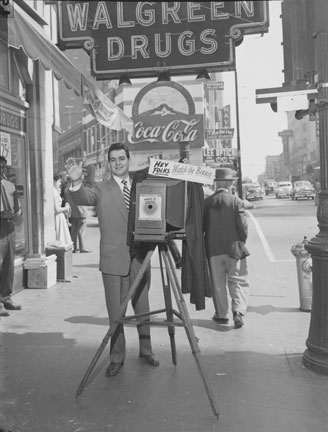Say Cheese!

Avoid Those Fake Smiles
The classic "say cheese" in the United States is a way of getting someone to look directly into a camera and smile as a deliberate attempt to coax a person to smile. There is apparently some science behind it. Look into a mirror and notice how your cheeks tend to lift up, your mouth widens and your teeth begin to show. The phrase is almost impossible to trace back to when and how it originated and is probably as old as the first cameras. (Along with its rival phrase "watch the birdie.")
In any case, the goal for the photographer is to get a natural expression with a relaxed and jovial atmosphere. (While conducting research on the physiology of facial expressions, French physician Guillaume Duchenne isolated one type of smile, later dubbed a "Duchenne" smile, which is one that involves groups of muscles around the mouth AND the muscles that raise up the cheeks and uses the eyes.)
Many researchers believe that Duchenne smiles are only generated when genuine and spontaneous emotions show up but you know it when you see one and you usually return the favor!
It appears to be the "ee" in "say cheese" that has worked for eons, so maybe try some variations next time you would like someone to smile for the camera with "money", "whiskey", "boogie", "piggy", or "gooey slime"...if the age is appropriate. (What other "ee" words would apply for you?)
Break The Tension
Lighten The Mood
Non-Duchenne or "forced" smiles are easy to fall back on and always look that way and why freeze one in time? In fact, they were also said to be "Pan Am" smiles, you know, the type where the flight attendant waves you on to the plane. Make it fun to smile for the camera since laughter "with you" or "at" you will produce some real looking smiles in either case. If "cheese" is too generic for you, maybe try "double Glouster", "Cornish yarg", "Sage Derby", "Shropshire blue", or "Caerphilly". Just kidding, but you get the point.
"Cheese" is universally used around the world. The Japanese have adopted it as "chiizu." Some in France have used "ouistiti" (which means marmoset). In Brasil, the letter X in the alphabet is called xis and is pronounce "sheez" and thus sometimes used. In Poland you may hear, "zaubern ser" (cheese) or in Romania, "zambeste" as a translation for "smile."
Ask a friend familiar with a foreign language or culture to tell you what they have found to work. Try it next time you need someone to smile, see what type of reaction you get and have a new conversation topic.
The key is to get people to forget that the camera that is pointed at them. For self-conscious subjects, Have them turn sideways and look over their shoulder at you or lean slightly forward with their chin out. (Remember the school photographer putting you in contorted poses that ended up looking natural later when you saw the photo but didn't feel that way at the time?)
Say Cheese During
a Game of SnapShotz
Remember the fun you had around a table with a board game? We think it is the perfect opportunity to take photos together. The SnapShotz Photography Board Game is simple and easy to play but with unlimited outcomes and results.
Use any digital camera or smart phone or tablet and ADD your favorite Photography Booth type props and away you go! Raid your attic or closets and check out party and costume stores like
Party City
. There are a ton of options with online photography prop shops and they really do help break the mood.
SnapShotz is designed for people who love to take photos and "seflies" and even for the more camera shy and "photo allergic" relative or friend.
Learn more with the
SnapShotz Game
button on our home page. If you want to order a game, please use the
Add to Cart
button on our NAV bar on the left side of this web page.
Return to Home Page from Say Cheese